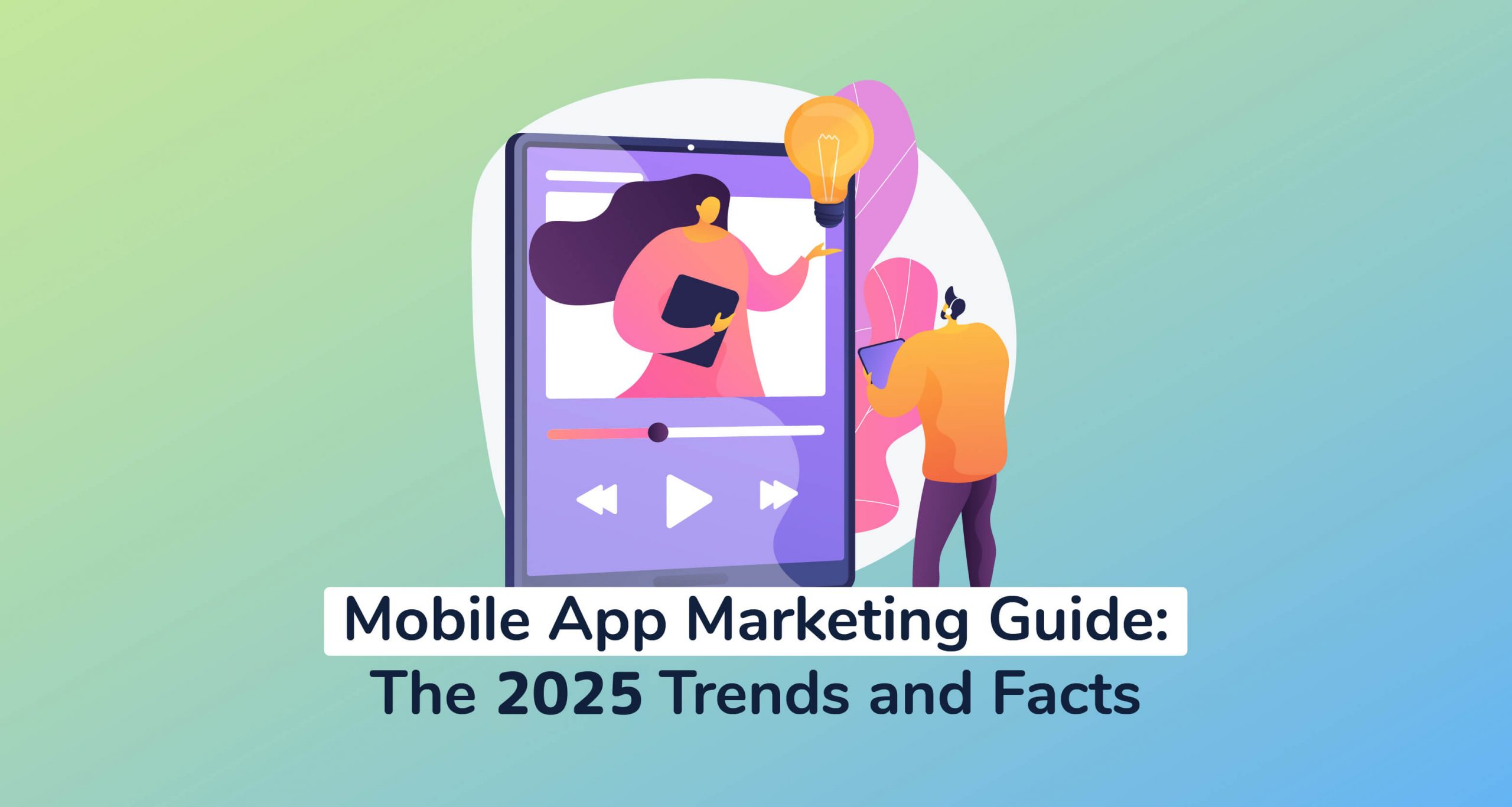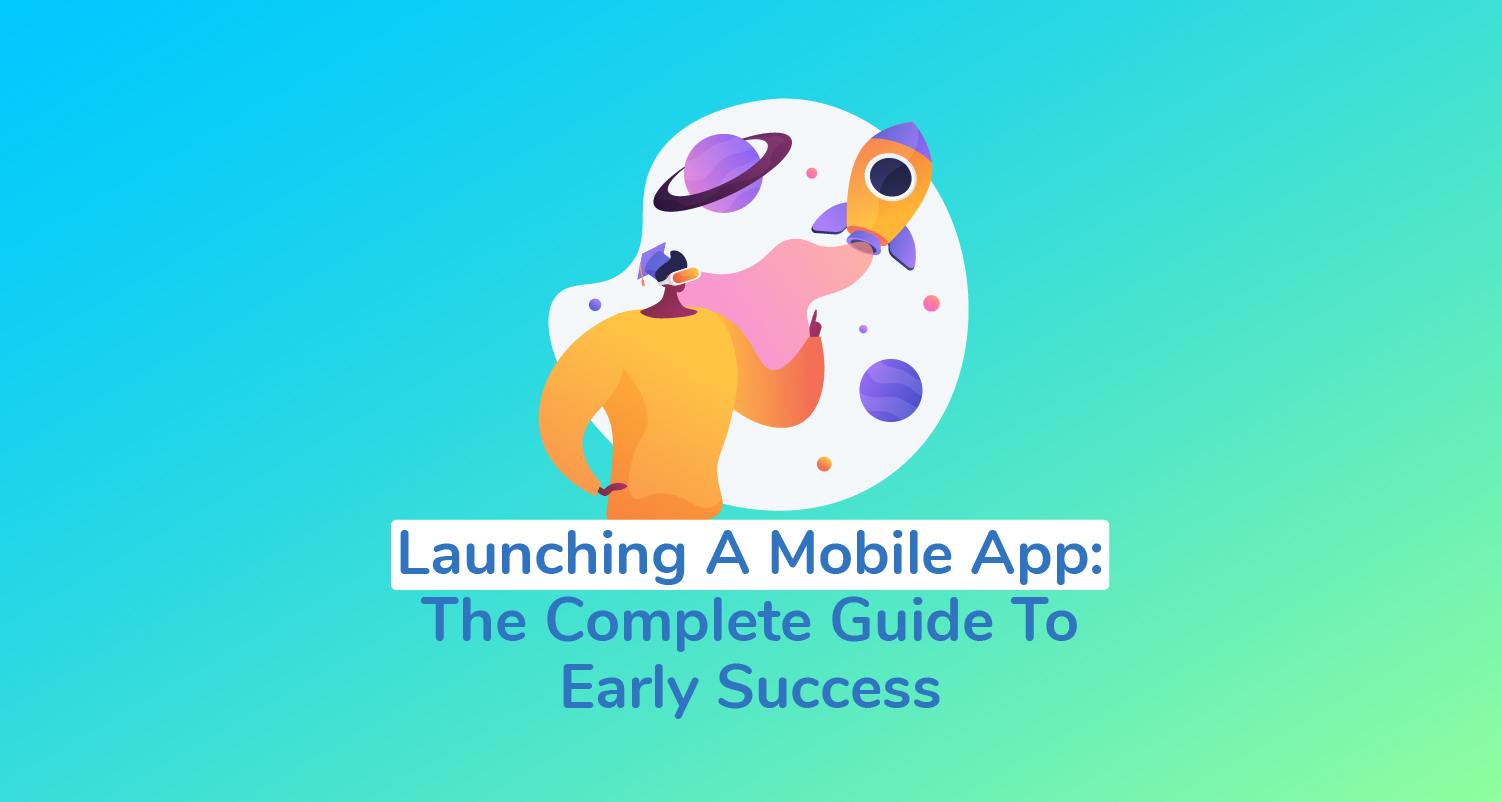
How To Market A Game App – 10 Tactics For Mobile Gaming Winners
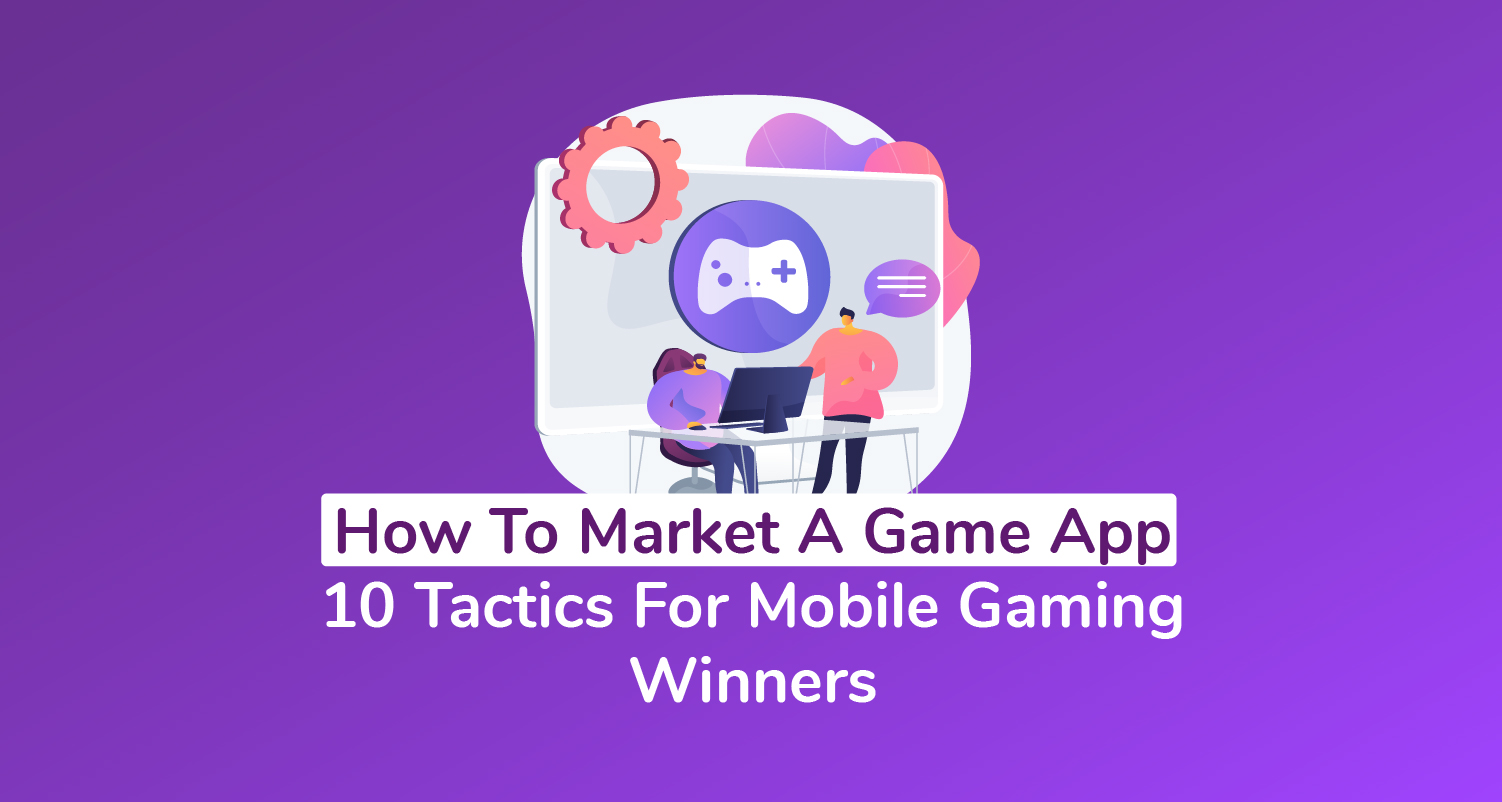
When it comes to marketing a mobile gaming app, one particularly curious case that stands out above the rest is that of popular hyper-casual games.
Table of Contents
- The Status Of The Mobile Game App Industry
- The Level of Competition In The Mobile Game App Industry
- Mobile Game Marketing 101 – 10 Simple Ways To Promote Your Gaming App
- #1. Generate Pre-Launch Buzz With App Press Releases
- #2. Seek App Reviews From Third-Party Platforms And Analyze User Feedback
- #3. Maximize Your App Store Optimization
- #4. Build Organic Web Traffic
- #5. Run Paid Game Ads
- #6. Tease Your Audience With Viral Videos
- #7. Facilitate Social Media Sharing Of User-Generated Content
- #8. Reach Out To Digital Influencers
- #9. Engage In Cross-App Marketing
- #10. Extend To Third-Party App Distribution Platforms
- Key Takeaways
Think about it. Doesn’t it seem kinda odd that the mobile gaming industry is dominated by minimalistic mobile game apps like Candy Crush Saga?
Don’t get me wrong. I’m not saying that Candy Crush isn’t all that – but rather, we’ve seen it outperform thousands of gaming apps with far superior graphics. Even the super high definition mobile remakes of popular video games are nowhere close to Candy Crush’s success.
You see, Candy Crush Saga isn’t just at the top of the app that installs leaderboard. In addition to downloading it more than 2.7 billion times, mobile gamers across the globe have pushed Candy Crush Saga to the peak in terms of usage and revenue.
In the iOS App Store, for instance, Roblox is the only mobile gaming app that generates more revenue. You’ll find Candy Crush Saga ranking second among the top-grossing mobile game apps – with an impressive daily revenue of more than 2 million dollars.
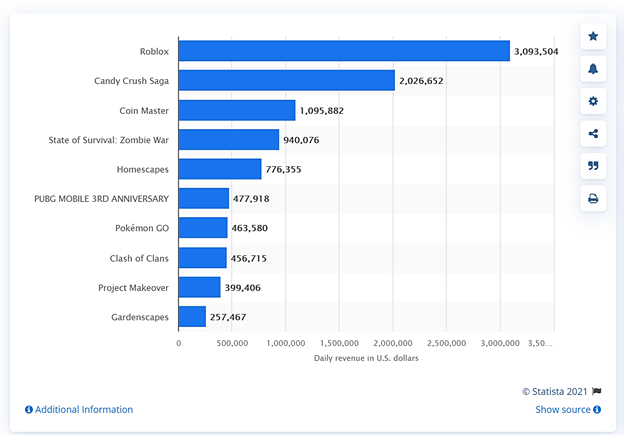
And how did that come to be?
Well, you could say that Candy Crush’s game developers played a part in its success. But, the fact of the matter is, this gaming app’s dominance has a lot to do with its strategic mobile app marketing.
Candy Crush Saga is one of the few apps that have not only mastered the intricate art of marketing gaming apps but also continue to progressively adjust their app promotion tactics as the market evolves.
I’m saying so with deep conviction because for over ten years now, I’ve used the same promotion strategies to successfully market hundreds of mobile game apps – they range from organic app campaigns to paid gaming ads across multiple digital platforms.
We’ve now compressed all the findings into this comprehensive guide – which goes beyond the generic mobile marketing strategies to focus entirely on just the tactics for marketing mobile game apps.
Follow along to learn 10 solid tactics that have been proven effective by not just Candy Crush Saga, but also thousands of other successful mobile game apps.
Well, if you’re in a hurry, you can go ahead and jump straight to the section that details all these mobile game marketing approach. But, if you’d like to understand their context at a much deeper level, I strongly advise you to familiarize yourself with the market dynamics that you should expect in today’s mobile gaming industry.
Here are the basics that you might want to know about the mobile game app market:
The Status Of The Mobile Game App Industry
Mobile device processors have indeed come a long way since the times when Nokia’s Snake dominated the mobile game industry. In fact, some smartphones are now even more robust than standard PCs.
Interestingly, hardware companies are barely just getting started. You can expect them to continue amplifying not only the power that comes with the smartphones, but also their usability, interactiveness, and task handling.
With such mobile devices now processing billions of instructions per second, game developers – on the other hand – are progressively churning out gaming apps that are much more advanced in terms of graphics, user engagement, and overall intuitiveness.
As for the users, the new breed of mobile game apps is proving to be more addictive than ever. So much so, in fact, that the mobile gaming app category now leads in popularity, download rates, user retention rates, and revenue.
Consider, for instance, the simple fact that 62% of smartphone owners tend to install a mobile game app within a week of acquiring new phones. And while the bulk of these users spend a total of 3-6 hours on their mobile devices every day, a significant chunk of that time is taken up by mobile gaming apps. Industry reports place the average at about 43%.
The obsession is particularly prevalent among mobile gamers, who’ve now grown to a population of over 2.7 billion strong. And when you consider even the casual players, it turns out that more than half of the internet users across the globe admit to playing mobile games on their smartphones – with the Asia-Pacific region going even as high as 71%.
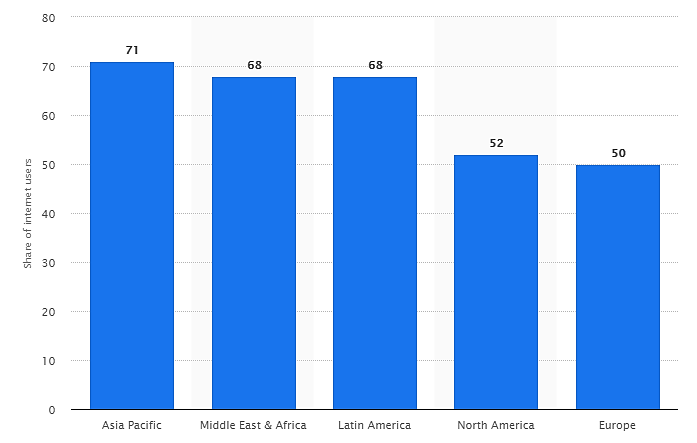
These trends have made mobile gaming apps the most popular app sub-category, accounting for a whopping 21.49% of active iOS apps. That’s twice as popular as the second-placed app category, which only manages 10.1%.
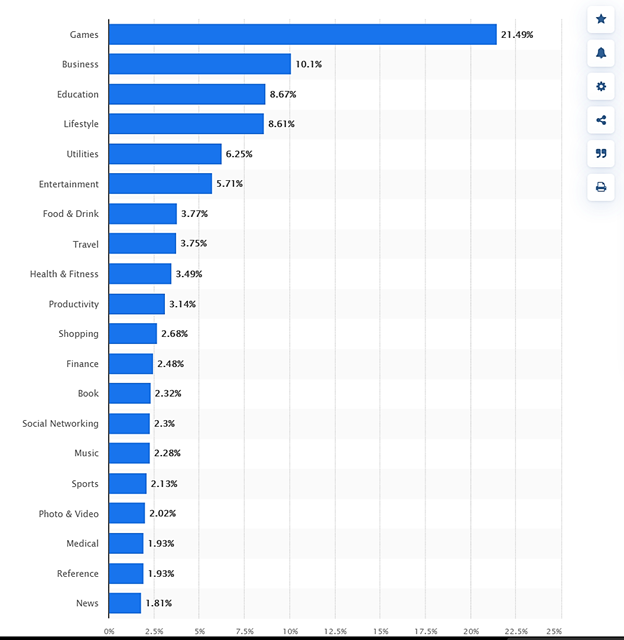
It’s because of these trends that mobile game apps are now generating a combined annual revenue of over $90 billion, up from $68.3 billion in 2019. By the time we get to 2024, it’s expected that the industry will have surpassed $116.4 billion.
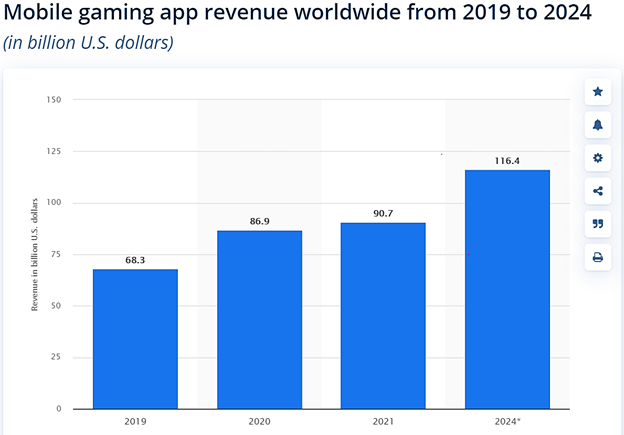
If you further break down the monetization figures across the mobile platforms, it just so happens that mobile gaming apps account for the largest chunk of the overall app revenues.
The Apple App Store, for instance, relies on mobile game apps for about 66% of its mobile app earnings.
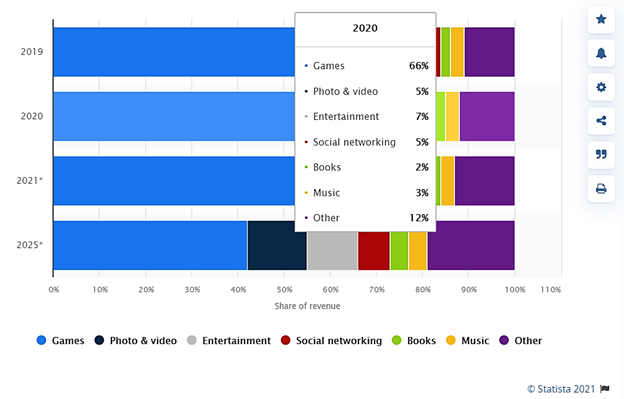
Then for Android apps, the stakes are much higher – as mobile gaming apps alone account for at least 83% of the total Google Play Store app revenue.
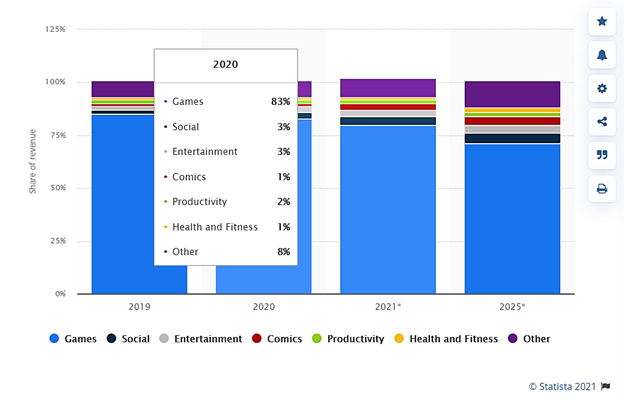
What does all this mean for you?
Well, you could argue that the industry indicators show that a mobile game app would be an exceptionally promising venture.
Unfortunately, however, that’s far from the truth. You see, the problem is, many game developers have already caught up on the positive industry news, and they all want a piece of the action.
The Level of Competition In The Mobile Game App Industry
By August 2021, the App Store alone had more than a million mobile game apps – which cumulatively translated to almost a third of its 3.7 million iOS apps.
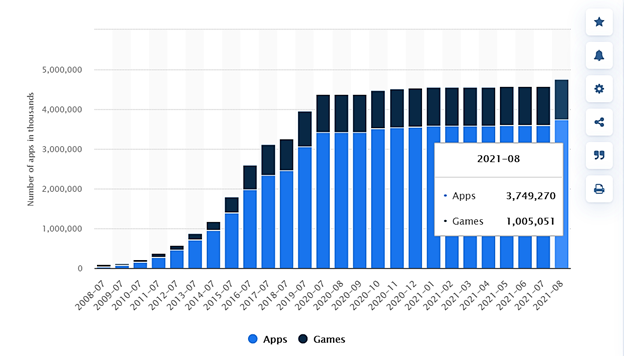
To put it all into perspective – if the App Store game apps were people, they’d fill up more than ten stadiums.
Going against such a multitude of competitors is not easy at all.
I’ve done it successfully, though. And not with one mobile gaming app, but on hundreds of occasions with different types of mobile games – from casual and hyper-casual games to the less mainstream types such as indie games.
The fundamental trick here is to push your mobile game marketing beyond your competitors’ standards. You need to build an omnichannel app marketing campaign that delivers with the precision of a Samurai sword.
It all starts with pre-launch app marketing, followed by app user acquisition campaigns, and then app user retention strategies complete the equation.
Here are the 10 specific approaches that you out to consider while you’re at it:
Mobile Game Marketing 101 – 10 Simple Ways To Promote Your Gaming App
#1. Generate Pre-Launch Buzz With App Press Releases

Make no mistake about this. Mobile game marketing doesn’t kick off after you’ve published your gaming app on the App Store. A perfect strategy starts with prelaunch app marketing.
This is where you reach out to your prospects long before even Apple reviews the mobile game for publishing. The goal is to generate buzz and get your target users talking before the app drops.
Now, the best approach here is to ride on the publications that are already popular with your target app users. You could, for example, reach out to influential journalists with a captivating press release about your upcoming mobile game app.
The only problem is, it takes a lot of finesse to grab the attention of renowned media publications. Their editors barely get the time to go through the received press release emails – and for the few that they manage to sample, only the most captivating story pitches are pursued, while the rest are simply ignored.
You can, however, save yourself the anguish by working with a well-connected mobile app marketing agency. Such mobile app marketers enjoy close ties with major media platforms – which would, of course, be open to running your story across their blogs, news publications, and social media pages.
That should get your followers talking, and the resultant buzz will gradually turn into word-of-word recommendations as you approach the actual app launch date.
#2. Seek App Reviews From Third-Party Platforms And Analyze User Feedback

Mobile app ratings on the App Store are very reliable in tracking overall user experience and potential bugs.
But, don’t limit yourself to the App Store review system. You shouldn’t just sit and wait for App Store publishing to start learning what mobile gamers think about your app.
There are numerous popular mobile app review forums that you can leverage ahead of the final app launch. You just need to build a beta version of your mobile game app, and then submit it to app review platforms that are frequented by mobile gamers.
They’ll then distribute the game app to testers who specialize in trying out upcoming mobile apps, before providing user feedback. Their remarks should eventually help you seal all the identified loopholes ahead of the app launch.
You could also have the app reviewed by influential mobile gaming blogs and social media personalities. By publishing review features that highlight the game app’s positive features, they’ll be helping you warm the market before the launch D-Day.
#3. Maximize Your App Store Optimization
Going by Forrester’s research study on mobile app discovery methods, it turns out that users predominantly learn about their newly-downloaded apps while browsing in the App Store.
To be specific, 63% of the installed iOS apps are discovered through App Store browsing, while 58% of the downloaded Android apps are as a direct result of surfing within the Google Play Store.
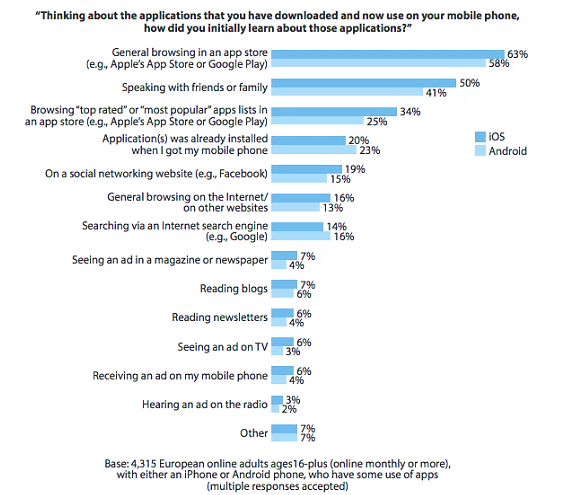
Now, that’s precisely where App Store Optimization (ASO) comes into play.
It is, by far, the most reliable way to organically market your mobile game app within the App Store and Google Play Store. This is where you align your app page’s elements with the App Store search algorithm, in a bid to secure favorable ranking positions within the search results.
You could, for instance, start by inserting the most relevant search terms within the keyword and app description fields. You could even throw in the brand names of your popular competitors to capitalize on their prominence.
Other than that, consider optimizing even the app title, app name, app screenshots, app description, app icon, app demo videos, app review, and overall user engagement.
Here’s a word of caution, though. Don’t base your App Store Optimization tweaks on random assumptions about the search trends. You should, instead, build it all while referencing accurate insights from advanced ASO tools.
PreApps AppReport is a great example of an ideal one for both non-skilled beginners and professional mobile app marketers. It’ll dig deep into your App Store and Google Play Store pages to provide actionable intel on your ASO parameters and overall ranking trends.
Then get this. You won’t pay anything for all that. The is one of the few free ASO tools that come with an all-inclusive set of robust features.
#4. Build Organic Web Traffic

The App Store is only one part of your app discovery strategy. While optimizing your mobile game app page will help you attract and capture App Store surfers, it’s not advisable to put all your eggs in one basket.
The web is a wide jungle that offers endless organic traffic generation opportunities across multiple platforms. As such, you might want to cast your fishing net beyond the App Store by creating a powerful online presence. This will subsequently help you to not only spread awareness about your mobile gaming app but also grow your organic traffic over the long haul.
You could, for instance, set up a website, or maybe establish your brand across mobile gaming forums and social media.
Such a site would act as the core launch pad for all your digital mobile app marketing campaigns. That means you get to connect with prospects through landing pages and blogging – while, at the same time, increasing visibility and generating traffic through SEO. We’ve seen that Google search alone accounts for 14-16% of all mobile app discoveries.
Social media, on the other hand, stretches as far as 19%. So, you might want to grow a solid following on sites like Facebook, Instagram, Twitter, YouTube, Snapchat, and TikTok. The trick is to find a way to keep your audiences engaged with valuable content.
#5. Run Paid Game Ads
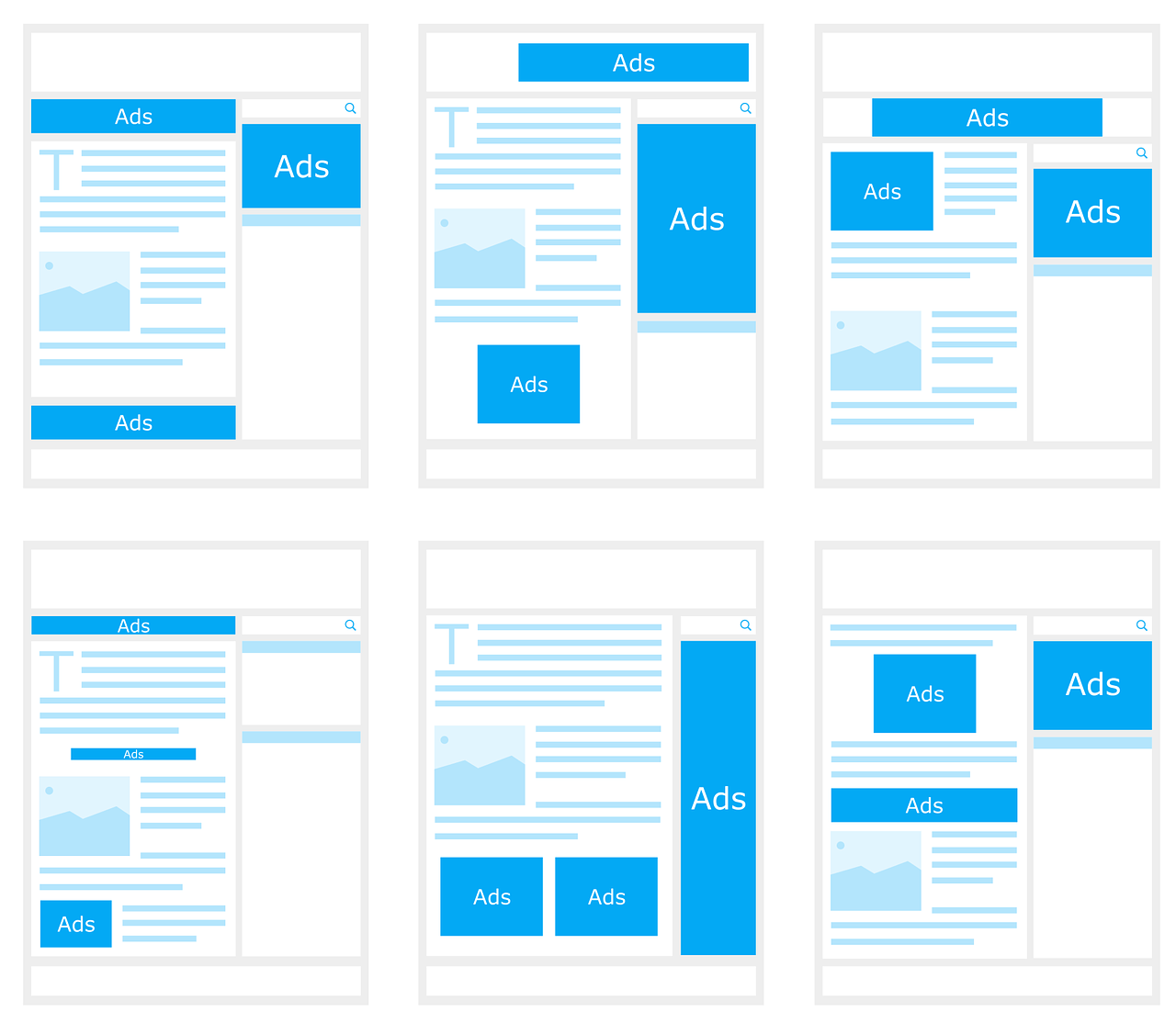
Here’s something I’m pretty sure you’ve seen before – mobile game apps running sponsored ads on social media sites like Instagram and Facebook.
You see, organic mobile game marketing campaigns will indeed get you warm leads for free. But, on the flip side, it takes time and a lot of persistent efforts to build a decent following.
As for mobile ads, however, you’ll be spending money to target audiences with hard-sell adverts. The point here is to drive quick conversions instead of gradually nurturing the prospects.
Now, for the best possible outcome, your mobile game marketing plan should leverage both organic and paid app marketing. This complementary approach, on average, attracts 25% more clicks than one-side campaigns – which subsequently translates to 27% higher profits.
One of my favorite channels for paid mobile game ads is Facebook, as it offers a host of granular targeting capabilities. What’s more, you get to display the ads through multimedia app ads, from where users can proceed to install the mobile games without App Store redirects.
Such campaigns run on just the Facebook main site, but also across Instagram and Messenger.
Twitter is another great platform for paid mobile app ads, thanks to its neatly embedded app install cards. Otherwise, you might also want to sample YouTube’s TrueView in-stream ads.
All in all, however, it’s worth noting that Google Universal App Campaigns (UAC) is the overall king of digital paid app marketing. It allows you to intelligently automate your paid game ads across Google’s campaign assets.
#6. Tease Your Audience With Viral Videos
In a study titled “Quantifying Movie Magic with Google Search”, Google managed to prove a direct correlation between movie sales and YouTube trailers. It established that a well-placed movie trailer almost always leads to box office success.
And that’s not all. Google further analyzed the trends in detail, and then came up with a formula for predicting upcoming movie sales based on trailer viewership – which had an accuracy of 94%.
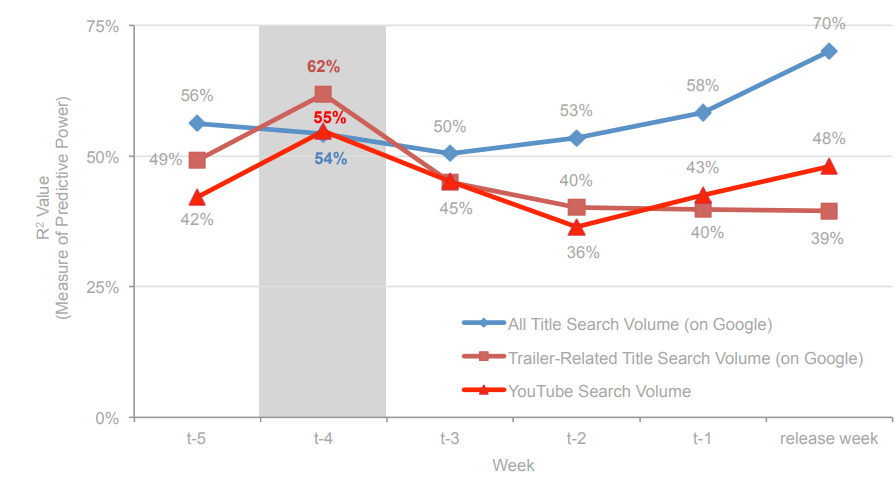
My point?
Quite simple, actually. Just as upcoming movies successfully use YouTube trailers to tease audiences and generate interest, you too could take advantage of video marketing to achieve the same.
Viral video marketing is the name of this mobile game marketing tactic. It entails creating short high-quality app videos that offer just enough details to elicit curiosity and widespread interest.
The videos are then distributed across social media sites, where they quickly gain traction by educating, exciting, and inspiring users to download your mobile game app.
Now, don’t mistake this type of content with App Store demo videos. While demos are intended to give you a feel of the user interface, viral videos are built to be shared widely across social media platforms, for the sake of increasing awareness and boosting mobile app downloads.
#7. Facilitate Social Media Sharing Of User-Generated Content

Do you know that celebratory feeling that comes with game achievements?
For many mobile gamers, the one thing that would make it even more satisfying is the sharing of the news with friends. Breaking a gaming record, for instance, feels so much better when you share the achievement with friends.
Now, this is something that you can easily take advantage of to drive mobile app downloads through peer-to-peer recommendations.
It starts by embedding basic social sharing buttons within strategic areas of the gameplay. For instance – consider attaching them to game achievements, as well as on personalized user-generated content.
With that, your mobile game players will gladly share the content with their peers across social media sites and gaming forums. This will subsequently influence friends to try out the game for themselves – which would lead to more app installs, followed by additional instances of social sharing. And the cycle would continue for the long haul.
These are types of peer recommendations that 70% of Millennials find to be heavily influential.
#8. Reach Out To Digital Influencers
Using organic engagements to progressively market a game app is a commendable strategy. But unfortunately, it’s not always enough.
There are times when you need to stretch beyond that, and possibly reach out to the really popular crowd for that extra kick that’ll take your app marketing campaign to the next level.
I’m talking about the influential individuals who happen to be widely recognized by your target app users.
Well, you might consider trying out celebrities. But, we know how that usually goes.
Their product endorsement fees typically go into the hundreds of thousands to millions of dollars, especially when you’re dealing with the A-list crowd. Then to make matters worse, A-list celebrity campaigns usually just feature products without driving real engagement.
Certainly not my style. I, instead, prefer working closely with digital influencers.
They may not be as flashy as regular celebrities, but they’re bound to get those numbers rolling – and, perhaps unsurprisingly, even more than A-list celebrities. Besides, it just so happens that 30% of prospects trust influencer recommendations way more than celebrity endorsements.
And that’s not all. Influencer marketing has, over the years, proved that it can outdo even traditional advertising – as it generates up to 11 times more ROI.
In particular, influencer marketing is quite handy on Instagram, followed by Facebook, and then blogs – with Snapchat lagging far behind, just below Twitter, Pinterest, and YouTube.
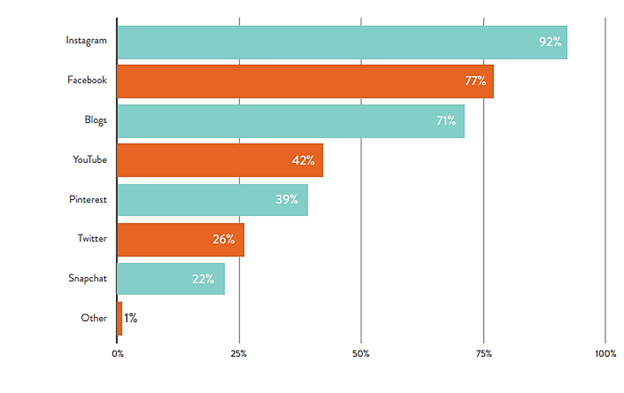
Please remember, though, that mobile game marketing should only be left to mobile gamer influencers. They’ve been shown to influence user purchase decisions by 21% more than non-gamer influencers.
#9. Engage In Cross-App Marketing
Great app marketers consider all other apps to be potential competitors.
The best app marketers, on the other hand, engage a slightly different but more calculated approach. They understand that the race to the top position would be easier if they engaged in cross-app marketing.
Instead of restricting their mobile game marketing campaigns to the app’s audience, they reach out to collaborate with a range of apps in different categories. You’d be surprised by the sheer volume of conversions that comes from such collaborations.
A word of caution, though. Don’t be too desperate to partner with just any available mobile app. Stick only to the mobile apps that best compliment your game app.
#10. Extend To Third-Party App Distribution Platforms
Through a press statement, Apple’s CEO Tim Cook revealed that there are now 1.65 billion active Apple devices worldwide.
Now that translates to an amazingly extensive market, to say the least.
But, let’s not forget that while all these devices come with the App Store as the native app distribution platform, this is not the only source for iOS apps.
Every now and then, some users – including mobile gamers – go searching for cheaper, more exclusive iOS apps from third-party app distribution platforms such as AppCake, AppEven, and AppValley.
The same applies even to Android apps. Although Google Play Store is officially recognized as the native app distribution platform, there’s a wide range of alternative options for Android devices.
For example, millions of users are exceedingly downloading Android apps from third-party sites like Amazon App Store, GetJar, and Games Store App Market.
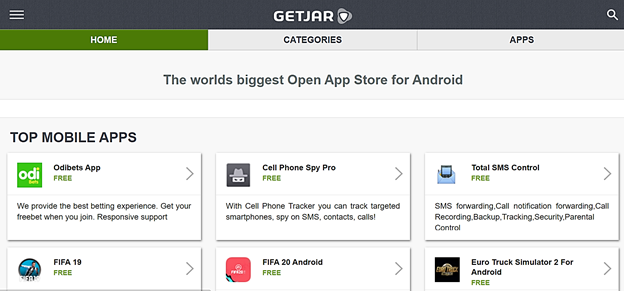
The bottom line?
Well, this is not the time to limit your mobile game marketing to just the native app distribution platforms. You should, instead, extend as much as you can, as fast as you can.
This might seem non-conventional at first. But, in the long run, spreading your mobile game app’s digital footprint might considerably boost your growth and overall market dominance.
Key Takeaways
To recap, here are the most important points that you might want to keep in mind:
- Candy Crush Saga ranks second among the top-grossing mobile game apps in the App Store – with an impressive daily revenue of more than 2 million dollars.
- With mobile devices now processing billions of instructions per second, game developers are progressively churning out gaming apps that are much more advanced in terms of graphics, user engagement, and overall intuitiveness.
- The mobile gaming app category now leads in popularity, download rates, user retention rates, and revenue.
- 62% of smartphone owners tend to install a mobile game app within a week of acquiring new phones.
- While the bulk of users spend a total of 3-6 hours on their mobile devices every day, a significant chunk of that time is taken up by mobile gaming apps. Industry reports place the average at about 43%.
- At a time when the number of mobile games is surpassing 2.7 billion, it turns out that more than half of the internet users across the globe admit to playing mobile games on their smartphones – with the Asia-Pacific region going even as high as 71%.
- Mobile gaming apps are the most popular app sub-category, accounting for a whopping 21.49% of active iOS apps. That’s twice as popular as the second-placed app category, which only manages 10.1%.
- Mobile game apps are now generating a combined annual revenue of over $90 billion, up from $68.3 billion in 2019. By the time we get to 2024, it’s expected that the industry will have surpassed $116.4 billion.
- The Apple App Store relies on mobile game apps for about 66% of its mobile app earnings.
- Mobile gaming apps alone account for at least 83% of the total Google Play Store app revenue.
- By August 2021, the App Store alone had more than a million mobile game apps – which cumulatively translated to almost a third of its 3.7 million iOS apps.
- Mobile game promotions start with pre-launch app marketing, followed by app user acquisition campaigns, and then app user retention strategies complete the equation.
- The goal of prelaunch app marketing is to generate buzz and get your target users talking before the app drops.
- The best way to create early buzz is to ride on the publications that are already popular with your target app users.
- You shouldn’t just sit and wait for App Store publishing to start learning what mobile gamers think about your app.
- You just need to build a beta version of your mobile game app and then submit it to the app review platforms that are frequented by mobile gamers.
- They’ll then distribute the game app to testers who specialize in trying out upcoming mobile apps, before providing user feedback.
- Going by Forrester’s research study on mobile app discovery methods, it turns out that users predominantly learn about their newly-downloaded apps while browsing in the App Store.
- 63% of the installed iOS apps are discovered through App Store browsing, while 58% of the downloaded Android apps are as a direct result of surfing within the Google Play Store.
- PreApps AppReport digs deep into your App Store and Google Play Store pages to provide actionable intel on your ASO parameters and overall ranking trends.
- Your website should act as the core launch pad for all your digital mobile app marketing campaigns.
- Google search alone accounts for 14-16% of all mobile app discoveries.
- Organic mobile game marketing campaigns will indeed get you warm leads for free. But, on the flip side, it takes time and a lot of persistent efforts to build a decent following.
- As for mobile ads, however, you’ll be spending money to target audiences with hard-sell adverts. The point here is to drive quick conversions instead of gradually nurturing the prospects.
- Your mobile game marketing plan should leverage both organic and paid app marketing. This complementary approach, on average, attracts 25% more clicks than one-side campaigns – which subsequently translates to 27% higher profits.
- Google Universal App Campaigns (UAC) is the overall king of digital paid app marketing. It allows you to intelligently automate your paid game ads across Google’s campaign assets.
- While app demo videos are intended to give you a feel of the user interface, viral videos are built to be shared widely across social media platforms, for the sake of increasing awareness and boosting mobile app downloads.
- Social buttons encourage your mobile game players to gladly share user-generated content with their peers across social media sites and gaming forums. This subsequently influences friends to try out the game for themselves – which then leads to more app installs, followed by additional instances of social sharing.
- 30% of prospects trust influencer recommendations way more than celebrity endorsements.
- Influencer marketing has, over the years, proved that it can outdo even traditional advertising – as it generates up to 11 times more ROI.
- Mobile gamer influencers influence user purchase decisions by 21% more than non-gamer influencers.
- Instead of restricting your mobile game marketing campaigns to the app’s audience, consider reaching out to collaborate with a range of apps in different categories.
Conclusion – Over To You
These ten tactics are proof that the concept of mobile game marketing is not that complicated.
But then again, don’t be quick to jump to conclusions. While the ideas might seem simple at first, things start to get a bit confusing when you ultimately get down to the mobile app marketing campaigns.
You see, each of these ten tactics involves a heck of a lot of intricacies from planning to the subsequent campaign rollout and management. You need to thoroughly review your business needs, define your target audiences, set up automated marketing tools, systematically integrate multiple channels to facilitate continuous omnichannel experiences, measure all your marketing efforts, track every single mobile app user, adjust approaches based on the changing market needs, customize campaigns for different locations, plus so much more.
Certainly not the type of stuff you’d want to deal with as you build your mobile game app business. Luckily you’ve got PreApps at your disposal, ready to piece together a well-streamlined mobile app marketing campaign for your gaming app. Just let us know your mobile app growth plans, and our expert team will gladly take it from there – leaving you to focus your time and energy on running the business.
Newsletter
Don’t miss a thing! Sign up to receive daily news
Subscribe Newsletter




